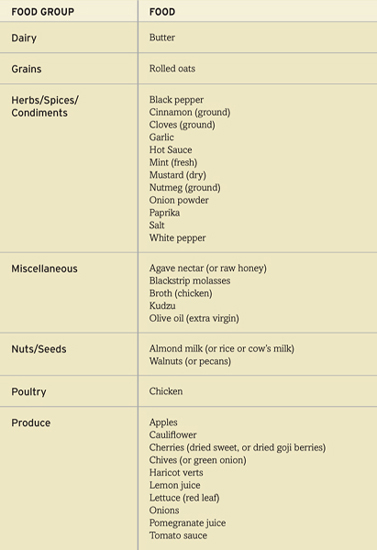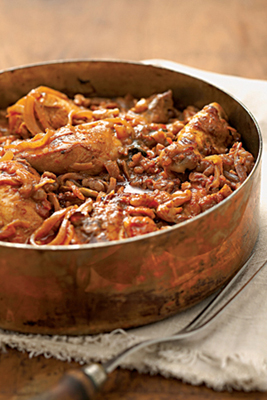

Persian-Style Chicken with Walnut, Onion, and Pomegranate Sauce
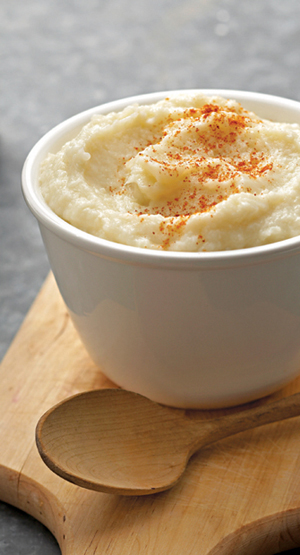
Cauliflower “Cream”
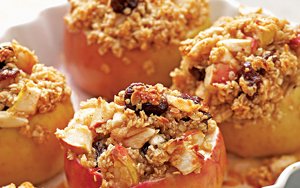
Haricot Verts with Pomegranate Mint
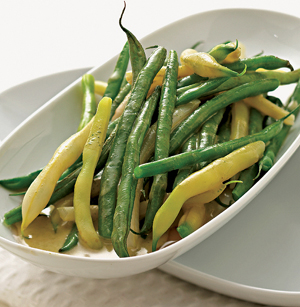
Baked Apples
182 Persian-Style Chicken with Walnut, Onion, and Pomegranate Sauce
186 Haricot Verts with Pomegranate Mint
CHICKEN, apples, walnuts, butter, blackstrap molasses, dried cherries, pomegranate juice, and honey. If that list of ingredients doesn’t make your mouth water, I don’t know what will. And every one of them can be found in this original, cleverly balanced meal of usual and not-so-usual ingredients mixed together for a veritable health bonanza.
What gives the Persian-Style Chicken with Walnut, Onion, and Pomegranate Sauce its unique flavor and feel is the combo of pomegranate juice and walnuts (or pecans) sweetened with iron- and mineral-rich blackstrap molasses, which is one of the best sweeteners on the planet. Read on.
AND THE OSCAR GOES TO … POMEGRANATE
In my book The 150 Healthiest Foods on Earth, I wrote that if pomegranate juice were an actress, it would be considered a “rising star.” Though pomegranate juice was practically unknown in the United States just a few short years ago, it has since been the subject of a ton of research, and the results have been so impressive that even mainstream medicine is paying attention to this new star on the superfood horizon. Pomegranate juice is protective against heart disease and cancer, plus it’s even been called “a natural Viagra”! (I knew that would get your attention!)
Research recently published in the Journal of Urology examined the effect of long-term intake of pomegranate juice on erectile dysfunction. The researchers established that free radicals—those rogue molecules that can damage your cells and DNA—have a profound effect on erectile dysfunction. Enter the juice of the pomegranate. Because of pomegranate juice’s powerful antioxidant capabilities, it can help quench the free radicals and do damage control on their ability to harm cells. In earlier research done in Israel and California, scientists tested a bunch of juices and other drinks for antioxidant capacity and found that pomegranate juice scored the highest of any drink they tested, including red wine and green tea. To that extent, it just might deserve the nickname “natural Viagra.”
Pomegranate also has the capacity to slow aging and protect against disease. In one study, forty-eight men who had been treated for prostate cancer with either surgery or radiation were given eight ounces of pomegranate juice to drink daily. Drinking the juice significantly lengthened the time it took for the men’s average PSA numbers (a marker for prostate cancer) to double. While the juice didn’t stop the progression of the disease, it significantly lengthened the time it took to develop, indicating that there may be chemicals in the juice that have some cancer-fighting benefits.
Then there’s the heart. In a study published in the American Journal of the College of Cardiologists, eight ounces of pomegranate juice were given to forty-five patients who had ischemic heart disease. Compared to non–juice drinkers, the patients drinking the pomegranate juice had less oxygen deficiency to the heart during exercise, suggesting improved blood flow to the heart. Not only that, pomegranate has shown that it has the ability to inhibit oxidation—or damage—to LDL (“bad”) cholesterol. Because LDL is only a real problem in the body when it’s oxidized, anything preventing oxidation is a bonanza for the heart and for cardiovascular health in general. Meanwhile, a number of other studies have shown a beneficial effect of pomegranate juice on cardiovascular health, including one that showed that it reduced arterial plaque.
The Best Salt to Use
Believe it or not, all salt is not the same. The healthiest type of salt to use is a high-quality, unrefined sea salt, not the typical iodized salt you find so nicely packaged at the grocery store. Truth be told, that all-too-common table salt, which comes from salt mines, has been dried at extremely high temperatures, altering its chemical structure and thus stripping away many of its beneficial elements. What remains in this process is sodium chloride, a substance that’s actually foreign to the body (kind of like those trans fats I rant about). To top it off, harmful additives and chemicals (such as aluminum silicate) are often added in during processing.
On the other hand, unrefined sea salt, which is harvested from a living ocean or sea, contains a wonderful array of elements that the body can benefit from, including iron, magnesium, calcium, potassium, manganese, zinc, and iodine. One noticeable difference is that you won’t get that typical bloating that results from using regular table salt. And for the icing on the cake: Sea salt is most definitely more flavorful than your typical table salt.
AS HEALTHY AS MOLASSES IN JANUARY
Another superstar food in this meal is blackstrap molasses. I said it’s one of the best sweeteners on the planet, and here’s why. Molasses is actually the by-product of sugar refining, the stuff the white sugar producers leave behind because nobody wants it. But it actually contains all the nutrients from the raw sugarcane plant. Because the roots of the sugarcane plant grow pretty deep, they’re able to receive a broad range of minerals and trace elements from those deep layers of the soil. Then, when sugarcane is refined, the plants are boiled to a syrup from which the crystals are extracted. Then the plants are boiled two more times, both of which produce molasses, but blackstrap molasses only comes from the third and final boiling. It’s essentially the “dregs” of the barrel, but it contains the most nutrition. It has a low amount of sugar and a high amount of nutrients, including iron, potassium, calcium, magnesium, and especially manganese and copper. And although blackstrap molasses has the least amount of sugar of the molasses family, it has more than enough to impart a delicious taste of unusual sweetness to this remarkable chicken dish.
“KING” CAULIFLOWER AND OTHER SUBJECTS
When I’m giving my general nutritional recommendations in “shorthand” at seminars, I often say something like “get the white stuff out,” meaning ban anything white from your diet. But I remind people that there are a few exceptions—very few—to that rule. One of them is cauliflower, one of the few “white things” that’s actually good for you.
Cauliflower, featured in this meal in Cauliflower “Cream,” is a member of that famous family of vegetable royalty, the Brassica family, which also includes cabbage and Brussels sprouts. Cauliflower contains indoles, a group of potent cancer fighters, and it also contains a phenomenal plant chemical called sulforaphane. Sulforaphane is a potent antioxidant and stimulator of natural detoxifying enzymes in the body.

The Cauliflower “Cream” is one of the most amazing substitutes for mashed potatoes I’ve ever tasted. I think it was Arthur Agatston, M.D., the South Beach Diet pioneer, who first started promoting cauliflower as a substitute for potatoes, and this recipe concept, suggested by our friend Lora Ruffner of Low-Carb Luxury fame, is always a crowd pleaser.
Haricot verts, as in the Haricot Verts with Pomegranate Mint, is the French term for green beans. Green beans contain folate and a bunch of other vitamins in small amounts, such as calcium, vitamin A, and potassium. They also contain about 20 percent of the Daily Value for manganese, a key trace mineral that’s important for growth, reproduction, wound healing, brain function, and metabolizing sugars, insulin, and cholesterol.
AN APPLE A DAY KEEPS DISEASES AWAY
Then for dessert, there’s Baked Apples, spiced up with butter, dried cherries (or goji berries), cinnamon, cloves, and rolled oats. Grandma was right: An apple a day really does keep the doctor away. And as it turns out, probably a whole lot more than just the doctor. When researchers examined the dietary habits of more than 34,000 women in the Iowa Women’s Health Study, they found that three foods stood out for their significant ability to lower both the risk of coronary heart disease and cardiovascular disease: apples, pears, and red wine.
The reason? Plant compounds called flavonoids. Based on food-frequency questionnaires and data from the U.S. Department of Agriculture, researchers were able to approximate the flavonoid consumption of the women and calculate the impact of those flavonoids on their health. The results were impressive. Flavonoid-rich foods such as apples were associated with significant reduction in heart disease and overall mortality.
In the coloring of fruits and vegetables, there are thousands of molecules known collectively as polyphenols. Flavonoids are one particular class of these polyphenols. And the most abundant, most bioavailable, and most studied of these flavonoids is a compound called quercetin. Apples are a significant source of quercetin, which has quite a résumé of health benefits.
• The Cauliflower “Cream” is delicious, but it’s optional. If you’re trying to save time, you can omit it. But Cauliflower “Cream” makes a great alternative to mashed potatoes when you’re craving warming, nourishing comfort food.
• You can make the Haricot Verts with Pomegranate Mint ahead of time and let it chill in the fridge.
• Begin the meal prep with the Baked Apples. The wonderful aroma of baking apples will permeate your whole kitchen.
• When the apples are in the oven, begin the Persian-Style Chicken with Walnut, Onion, and Pomegranate Sauce.
• Once the chicken is simmering, prepare the Cauliflower “Cream.”
The quercetin in apples is, interestingly enough, in the peel, so for goodness’ sake, when you bake apples never peel them. The peel prevents the harmful effects of the UV rays of the sun from hurting the fruit and also prevents microbes from getting in. So quercetin is the first line of defense for the apple. It appears to have many of these same protective effects on human cells. Quercetin impacts the immune system, reacts against cancer cells, and is a powerful anti-inflammatory. Quercetin has been linked to a reduction in heart disease as well as to a reduction in lung cancer.
The polyphenols found in fruits such as apples act as both anti-inflammatories and antioxidants. In cardiovascular disease, inflammation and oxidation very much hasten or augment the process of plaque buildup, so anything that reduces inflammation and oxidation—such as quercetin and the other flavonoids in apples—is going to help.
This most recent study is just the latest in emerging research showing that what we eat can have a profound effect on our risk for a number of degenerative diseases. While the research continues to accumulate, it makes awfully good sense to keep eating as many fruits and vegetables as possible. After all, that’s where compounds like the flavonoids are found in abundance. As a nice added touch, the baked apple is peppered with goji berries, which are kind of a cross between a cranberry and a cherry. Goji berries have been used in Tibet and China for hundreds of years and are regarded as a longevity, strength-building, and sexual potency food of the highest order.
Enjoy!
Let me be honest. I always buy free-range chickens and eggs from “cage-free” hens. I’m also increasingly suspicious of whether those terms mean anything.
In an ideal world, the chickens that we eat would run around on small family farms, pecking away at the ground to forage for their natural diet of worms and insects and all the other omega-3-rich foods they would naturally eat. They’d get exercise, so they wouldn’t be so fat. They’d come from organic, conscientious farms so their bodies wouldn’t be filled with the growth hormones and antibiotics that the poultry industry uses on factory-farmed animals.
But this is far from an ideal world. Chickens are among the most abused animals on the planet. They’re packed by the thousands into filthy sheds, and each chicken has about as much space as a sheet of paper. They are fed massive amounts of antibiotics and drugs, including hormones to make them grow large and fast. They’re typically slaughtered at seven weeks or less, years short of their normal life span.
Free range and organicare labels we hope would assure us that the animals we eat had a life different from the one I just described. Free-range animals, in principle at least, are permitted to roam freely and live in natural surroundings. But unfortunately, there are few regulations on the term free range, and you can be pretty sure that it’s only a matter of time before the term becomes so diluted that it loses any real meaning. To give a “free-range” certification, the USDA simply requires that chickens have access to the outdoors. The key word is access. Often “access” simply means a little “doggy door” that few chickens even recognize, let alone use.
But yes, with all that said, I still buy free-range chickens. I like to hope that I have a better chance of getting a bird that had some semblance of a normal life, eating its normal diet, and ultimately—dare I hope—slaughtered humanely. Free-range, organic chicken—if it really is free range—is a healthier, tastier meat with less of the toxins I’d rather not have in my diet.
And buying free range lets me sleep a little better at night.
A delicious disease-fighter and anti-aging entrée
Prep Time: 5 to 10 minutes
Cook Time: 40 minutes
Ingredients
3 tablespoons (45 ml) unsalted butter or olive oil
2½- to 3-pound (1- to 1¼-kg) chicken, cut into serving pieces (see “Notes from the Kitchen”)
2 medium onions, thinly sliced
1 teaspoon ground cinnamon
2 cups (220 g) toasted walnuts or pecans, coarsely ground
⅔ cup (157 ml) pomegranate juice
½ cup (123 g) tomato sauce
1½ cups (355 ml) no-sodium-added, fat-free chicken broth
1 tablespoon (15 ml) plus 1 teaspoon freshly squeezed lemon juice
¼ teaspoon salt
¼ teaspoon ground black pepper
1 tablespoon (20 g) blackstrap molasses
In a large, heavy skillet or Dutch oven, heat the butter or oil over medium-high heat until melted and the foam subsides. Sauté the chicken, turning it occasionally, for 10 to 15 minutes, or until it is browned on all sides. Transfer the chicken to a plate. Reduce the heat to medium-low and add the onion to the skillet. Sauté, scraping up brown bits, for 10 minutes, or until it is golden and softened. Stir in the cinnamon and continue to cook, stirring constantly, for 1 more minute. Stir in the walnuts or pecans and cook the mixture, stirring, for 1 more minute. Stir in the pomegranate juice, tomato sauce, broth, lemon juice, salt, pepper, and molasses. Bring the mixture to a boil and simmer for 3 minutes. Add the chicken, leaving any juices that have accumulated on the plate, reduce heat, and simmer the mixture, covered, for 15 to 20 minutes, or until the chicken is cooked through.
Yield: 4 to 6 servings
• This unusual dish takes some preparation, but it is so delicious you won’t mind.
• Dutch ovens are perfect for slow cooking or simmering foods. As with this recipe, adding ingredients one at a time to a Dutch oven will allow you to appreciate and enjoy the many layers of flavors.
• You can substitute 3 pounds (1¼ kg) boneless, skinless chicken breast for the whole chicken to reduce the fat content, but you may need to reduce final cooking time.
Great Herbs and Spices for Poultry
• While it’s always fun to experiment with different flavors for poultry based on your own palate, here is a list of the most common, recommended seasonings to try: allspice, basil, bay leaf, bouquet garni, celery seed, chervil, chives, cilantro, ground coriander, cumin, curry powder, dill, fennel, fines herbes, ginger, green peppercorn, mace, marjoram, mustard, nutmeg, paprika, parsley, rosemary, saffron, sage, savory, tarragon, thyme, and turmeric.
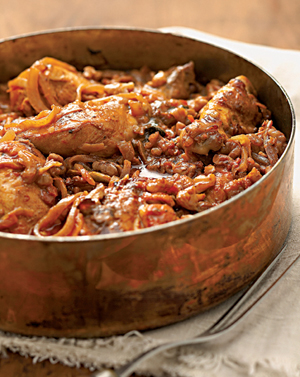
A detoxifying substitute for mashed potatoes
Prep Time: 5 minutes, plus 5 to 10 minutes after cooking
Cook Time: 20 to 25 minutes
Ingredients
4 cups (940 ml) low-sodium, fat-free chicken broth (one 32-ounce or 1-L carton)
1 large head cauliflower, trimmed and cut into florets, or two 10-ounce (280-g) packages frozen cauliflower
1 clove garlic, slightly crushed
½ cup (120 ml) unflavored unsweetened almond, rice, or cow’s milk (not soy milk)
2 tablespoons (28 g) butter
½ teaspoon salt
2 teaspoons (5 g) kudzu or thickener of your choice (see “Notes from the Kitchen”)
2 teaspoons (5 ml) cold water
¼ teaspoon ground white pepper
¼ teaspoon onion powder
½ cup (24 g) chopped chives or finely chopped green onion (greens only, no bulb)
Few dashes hot sauce or few sprinkles paprika, optional
If using fresh cauliflower, combine the broth with enough water to fill a large pot half full and bring to a boil. Add the cauliflower and garlic and reduce the heat, simmering over medium heat until very tender, 20 to 25 minutes. If using frozen cauliflower, cook the cauliflower and garlic on the stovetop in water or broth as directed until it is very well done—fall-apart fork tender. Drain the cauliflower well, blotting with paper towels to remove any extra moisture. (This step is crucial.)
In a small saucepan, heat the milk with the butter and salt until warm (or scalded), but not boiling.
In a small bowl, mix the kudzu with the water until dissolved and add it to the heated milk mixture. Cook for about 1 minute until the mixture thickens, stirring constantly with a whisk to help prevent lumps.
In batches if necessary, put the still-warm cauliflower and garlic into blender with the warmed milk mixture. Blend until smooth. Add the pepper and onion powder and mix well. Stir in the chives or green onion and hot sauce or paprika, if using, and serve.
Yield: 6 servings
• This is a very mild dish because cauliflower can be a little bland. Punch it up with pungent flavors such as paprika, cayenne, or garlic salt to give it a little more snap.
• This dish makes a taste-comparable, low-carb, and much healthier alternative to plain mashed potatoes.
• Kudzu (kuzu) is a starchy root that is used as a thickener much like cornstarch is used for sauces, stews, and gravies. The difference is that kudzu is more nutritious and rich in protein as well as vitamins. And because of its high fiber content, kudzu also supports good digestion. Look for it in natural grocery stores or Asian markets.
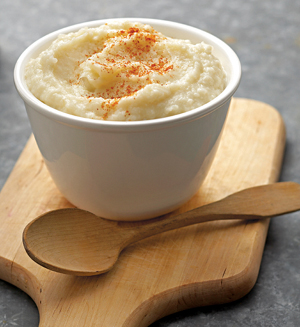
Get your manganese here
Prep Time: 10 to 15 minutes
Cook Time: 5 minutes
Ingredients
1 pound (455 g) haricot verts, washed and stems removed
¾ cup (175 ml) pomegranate juice
¼ cup (60 ml) extra virgin olive oil
1 tablespoon (15 ml) lemon juice
2 tablespoons (12 g) fresh mint, chopped
¼ teaspoon dry mustard
Small pinch salt
1 head red leaf lettuce, washed and leaves separated
Extra mint leaves for garnish, optional
Bring a large pot of salted water to a boil. Add the haricot verts, cooking until al dente, about 5 minutes.
While the beans are boiling, fill a large bowl with ice water. When the beans are cooked, pour them out into a colander, draining completely. Plunge the colander immediately into the bowl of ice water. Let the beans stand for about 5 minutes and drain again. Pat the beans dry with paper towels, transfer them to a covered dish, and refrigerate while making the dressing.
In a blender, place the pomegranate juice, oil, lemon juice, mint, mustard, and salt. Blend well until the mint is finely chopped and the dressing turns pink.
Arrange the lettuce on a large platter, placing the bottoms toward the center.
Arrange the haricot verts on top of the lettuce. Drizzle 3 to 4 tablespoons (45 to 60 ml) of the dressing over all, to taste. Store the remaining dressing in a jar with a tight-fitting lid and shake before each use. Garnish with the mint leaves, if using.
Yield: 4 to 6 servings
• Haricot verts (fine green beans) are very fragile. Choose very fresh beans and cook them as soon as possible.
• If you prefer, it looks very pretty to use ½ pound (112 g) haricot verts and ½ pound (112 g) haricots blanc.
• You can substitute regular green beans for the haricot verts. However, the cook time can be longer, typically 7 to 10 minutes.
• You can freeze fresh herbs for use out of season. Rinse them, allow them to dry thoroughly, and put them between sheets of waxed paper in a resealable plastic bag or freezer storage container.
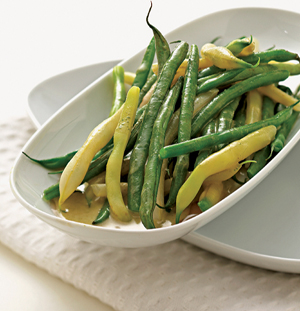
An apple a day keeps heart disease away
Prep Time: 10 minutes
Cook Time: 50 minutes
Ingredients
2 tablespoons (28 g) plus 1 teaspoon butter, at room temperature
¾ cup (59 g) rolled oats
⅓ cup (115 g) agave nectar or ¼ cup (85 g) raw honey
2 tablespoons (16 g) dried sweet cherries or dried goji berries
¼ teaspoon salt
1 teaspoon ground cinnamon
¼ teaspoon ground nutmeg
Small pinch ground cloves
4 large firm apples, such as Pink Lady or Cortland
Preheat the oven to 350°F (180°C, gas mark 4).
In a small bowl, cut 2 tablespoons (28 g) of the butter into the oats, agave nectar or honey, cherries or goji berries, salt, cinnamon, nutmeg, and cloves and mix together well.
Cut one-quarter off the top of each of the apples, remove the core from the top, and chop the remainder of the tops into small pieces. Hollow cores out of the apple bottoms to form cavities in the centers, leaving the bottoms intact and discarding the cores. (A butter knife works well for this.) Mix the chopped apple pieces into the oat mixture.
Spread the remaining 1 teaspoon butter inside of the apples. Place the apples into a glass pie pan. Fill the apples with the oat mixture, pressing firmly, allowing some of the mixture to spill out over the tops. Cover the pan loosely with foil and bake for 30 to 40 minutes. Uncover and cook 10 to 15 more minutes, until the oat crumble is lightly browned and the apples are soft.
Yield: 4 to 6 servings
• You can add ¼ cup (40 g) chopped nuts, such as almonds or walnuts, to the oat mixture.
• For a smokier, slightly bitter quality, use dried goji berries instead of the dried cherries.
• Simple baked apples actually make an excellent, sweet, high-fiber snack. Try baking them plain, cored, with no added fillers or sweeteners. Enjoy them warm or store them in the fridge for later. If you want a little more spice, try sticking 4 or 5 whole cloves into the sides while cooking. Just be sure to remove them before eating the apple!
• As a general rule of thumb, it is best to choose firm apples for baking and making pies. The best apples for baking are Rome, Jonagold, Granny Smith, Pippin, Braeburn, Northern Spy, Gravenstein, York, Cortland, Winesap, and Cameo. The worst apple for baking is the Gala. Cooking actually destroys Galas’ aroma and texture!
• You can substitute Red Delicious apples for the Pink Lady or Cortland apples in the recipe. Red Delicious actually has the highest antioxidant content of all the apples, but they take longer to cook and soften than the “baking apples.”
• Fall is definitely the best season for fresh apples. September through November, try to enjoy that extra freshness of apples from local apple orchards or those sold at your local farmers’ markets.
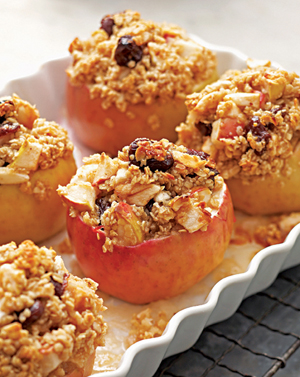
There are two schools of thought on when you just have to have a sweet.
School number one says: Don’t deny yourself. Have something good, enjoy it, and then get back on track. Try not to make it a habit.
School number two says: An alcoholic can’t have a moderate amount of alcohol. Just say no. Sweets create their own cravings. It’s easier to have none than to try to have a little.
I confess that I fall into both camps, though I’m more inclined to believe camp number two. That said, which school of thought is right probably depends on you. The alcoholic may not be able to have occasional alcohol, but the non-alcoholic certainly can. If you struggle with weight management issues, and you find yourself addicted to the very foods that bring you down, you’re probably better off with the philosophy of school number two. Your brain doesn’t process moderation. Step away from the sweets. It’s easier in the long run.
But if you’re okay with an occasional sweet snack or treat, and weight control isn’t a big problem for you (at least not the major problem in your life), go ahead and have some sweets from time to time.
And while you’re at it, consider these ideas for sweet-craving snacks that are least likely to produce out-of-control cravings of their own.
• Part-skim mozzarella stick or 1 oz cheddar with a medium apple
• Cubed Swiss cheese with berries or a small handful of dried fruit
• Apple or pear slices with nut butter
• Cottage cheese and fruit yogurt with cinnamon
• Cottage cheese with berries, apples, peaches, etc., sliced almonds, and cinnamon
• Rice, almond, soy, or low-fat cow milk and high fiber cereal or oatmeal with sliced almonds.
• Plain yogurt sweetened with agave nectar, or xylitol. Add granola, almonds, berries, peaches, dried fruit, wheat germ, ground flaxseed (like Barlean’s Forti-Flax), or any high fiber cereal
• Smoothies—see chapter 14 for suggestions
